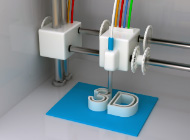
The advancement of technology leads to the birth of different methods of product development which benefited many people including engineers, designers, etc. These product development processes include 3D printing and rapid prototyping.
3D printing and Rapid prototyping are technologies used in additive manufacturing. But, some people think that these two are the same. Some are also confused between the difference of 3D Printing and Rapid Prototyping.
Technically, these two terms have similarities because both can create models layer by layer from an STL data. However, there are important components that are sometimes ignored. Here is a blog post to help distinguish between 3D Printing and Rapid Prototyping.
Clearing up the confusion - See below
Additive Manufacturing vs Subtractive Manufacturing
Nowadays, additive manufacturing plays an important role in the growth of product development. It does not only build products fast, but also makes the manufacturing process more innovative and cost-effective.
Additive Manufacturing or AM is a suitable name to describe the technology that is used in building 3D objects by adding materials layer by layer. The term “additive” refers to the method of adding and building the product repeatedly.
Additive manufacturing is an opposite method of subtractive manufacturing. Subtractive manufacturing is a process in which 3D objects are constructed by cutting materials through a standard machining process such as drilling or milling. It is also called the traditional manufacturing and used in CNC machining.
Additive Manufacturing vs 3D Printing vs Rapid Prototyping
To make things clear, 3D printing and additive manufacturing can be used interchangeably. Conversely, there is a commonly perceived difference between 3D printing and additive manufacturing. 3D printing is a term often used by media and general public, while additive manufacturing is a word frequently used by professionals in the industrial sectors.
3D printing is the right word to use when describing the process, but using additive manufacturing is more precise. Whereas, rapid prototyping is one of the applications that is used 3D printing or additive manufacturing technology to create new products.
Defining 3D printing and Rapid Prototyping
What is 3D Printing
3D printing is a manufacturing process which takes a digital 3D model and turns it into a physical object. In this process, a material is fabricated using a print head, nozzle or other printing technology.
What is Rapid Prototyping
Rapid Prototyping or RP is an application used in additive manufacturing to create a model faster than the normal process. Rapid prototyping is mainly completed using 3D printing or additive manufacturing technology.
From the definitions above, they show that 3D printing and Rapid prototyping are two similar terms being used in different industries. Furthermore, here are other components that make them different.
Difference between 3D printing and Rapid Prototyping
Price
There is a significant difference between the cost of 3D printing and rapid prototyping. From machine depreciation, materials to be used, labour, system maintenance, etc. Rapid prototyping technology can cost twice as much as 3D printing.
Moreover, maintaining a 3D printer can range to approximately a few thousand dollars per year. It is much cheaper compared to maintaining a rapid prototyping system which can cost up to $10,000 annually.
Complexity of the printing method
Using 3D printing requires less or even minimal training (depending on the complexity of components and supporting structures needed) compared to using rapid prototyping machines. With rapid prototyping, parameters are not so simple to adjust.
However, with 3D printing, it is possible to create parts right out of the box. Again depending on required accuracy of components. The higher the accuracey the long it takes to print a component. Creating 3D drawings tends to be the hold up for 3D printing but once a drawing is created producing parts are cheap, fast and easily repeated at any time.
Material choices
3D printing systems do not provide a wide range of material options unlike rapid prototyping. Even though the list of materials for 3D printing is advancing, it is not as available as rapid prototyping.
3D printing is limited to PVC and other plastic materials. Nevertheless, with the advancement of technology, materials such as ceramics may fully be available for 3D printing in the future.
Level of accuracy
When it comes to the level of accuracy, rapid prototyping systems can produce accurate and better finishes compared to 3D printing. Although both have similar features such as the size of parts and relying on a larger degree of geometry available, rapid prototyping system utilises more advanced specific part-accuracy technology.
Moreover, 3D printers are limited to producing smaller parts that can only fit in an 8-inch cube. Since 3D printers are small, they have minimal room to create accurate parts from the 3D Printing machine. With RP systems, build chambers are at least 10 inches on one side and others have 3x3x2 feet or larger.
Conclusion
Whether 3D printing or Rapid prototyping is being utilised, both of these technologies could be a great help to your business. It could bring greater opportunities for product development. It will also allow you to explore and check complex designs, which is a competitive advantage for growth and productivity.
If you need help with your 3D printing and rapid prototyping problems, a good starting point is to reach out to a reliable manufacturer in Sydney, Australia which provides services such as 3D design and printing, mechanical designs and drafting, rapid prototyping and many more prototyping techniques.









